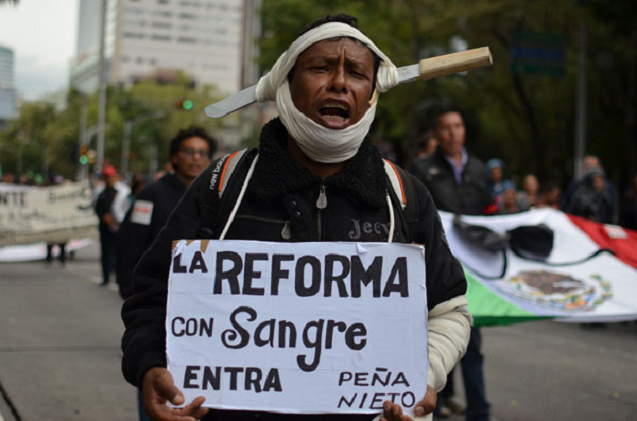
This year’s Mexico independence celebration came with an extremely high cost, and we’re not talking about the fireworks budget. In preparation to “liberate” Mexico City’s central plaza, the Zócalo, the government deployed 3,600 riot police, a water tank and two Black Hawk helicopters to evict a teacher’s encampment. Ironically the government violently evicted the monthlong legal protest encampment to scream “El Grito de Dolores” – a scream traditionally emitted by the president to commemorate the start of the Mexican War of Independence.
The teachers, who are part of the CNTE, the National Coordinating Committee of Education Workers, largely hail from the southern state of Oaxaca, whose population is largely indigenous and rural with alarmingly high rates of poverty. The CNTE occupied the Zócalo to voice its opposition to the new education reform and urge the government to negotiate with them. The teachers have criticized the reform – stating that it chips away at their labor rights, fails to recognize the diverse needs of students in rural indigenous communities and tries to impose a one-size-fits-all evaluation model. And, yes, these are the same teachers who seven years ago sparked a large uprising in opposition to Oaxacan Gov. Ulises Ruiz in which a popular assembly camped out in the main plaza of Oaxaca and installed protest barricades throughout the city for more than 7 months.
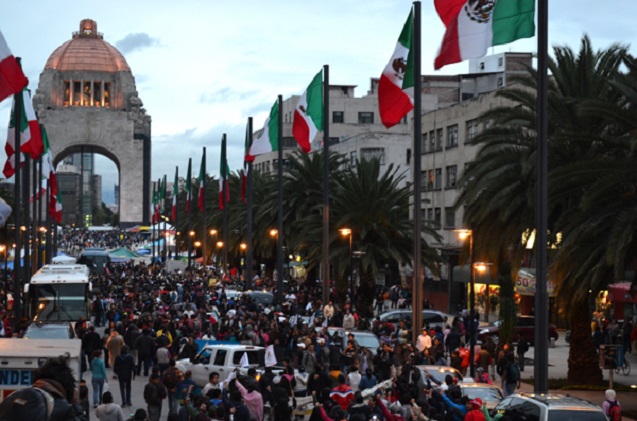 After being evicted from the Zócalo the teachers set up camp a mile away at the Monument of the Revolution. (Photo: Andalusia Knoll / Upside Down World).
After being evicted from the Zócalo the teachers set up camp a mile away at the Monument of the Revolution. (Photo: Andalusia Knoll / Upside Down World).
When Mexican President Enrique Peña Nieto took power on December 1, 2012, he vowed to drastically transform the country, which would include improving the quality of education. He immediately signed the “Pact for Mexico,” aligning the three major political parties, to “promote growth, create jobs & reduce poverty and social inequality.” Within its terms, Peña Nieto was able to easily change Articles 3 and 73 of Mexico’s Constitution to create a standardized system of teacher evaluation and grant schools what he defined as “autonomy.” This autonomy signifies that parents have to take more responsibility for the conditions of their children’s schools and financially invest resources to help them operate. Many viewed this clause as a step toward privatization.
The reform was implemented in February 2013 and was met immediately by protests on the major highways of the southern state of Guerrero. Teachers blocked the highly trafficked highway to the tourist destination of Acapulco and mobilized for a couple of months until the constant police repression and the lack of advances wore them out.
There were intermittent opposition protests in other parts of the country, but it was a series of secondary laws that were set to be passed in August that brought the teachers in droves to the capital, launching a strike just as the school year was set to start.
The secondary laws included The Professional Service Teachers Law (LSPD), which requires that teachers, principals and counselors be evaluated according to the standards of the National Institute for Educational Evaluation (INEE). Teachers will have up to three opportunities to pass the evaluations, and their failure to do so will lead to their firing or reassignment to an administrative position.
Oaxacan teacher Alfonso Arellano spoke to Truthout during a major street mobilization in Mexico City. He believes that the education reform is essentially an attack on workers’ rights.
“[The ‘reform’] goes after our rights as workers. It risks all of the labor rights that the teachers and the national union have gained with 30 years of struggle,” Arellano said.
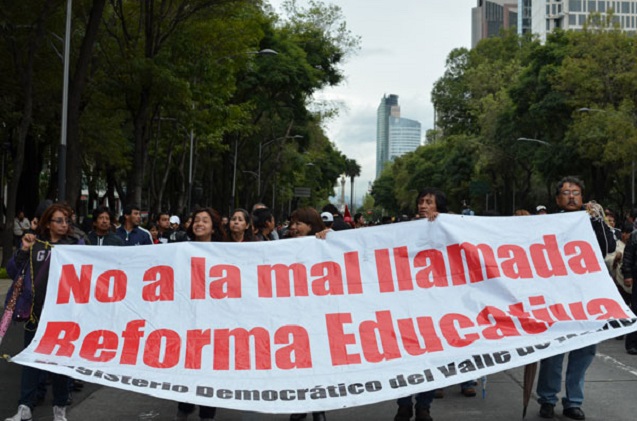 “Say No to the wrongly named Education Reform.” Many teachers have criticized the education reforms, saying that they do nothing to improve education and should be aptly called labor reforms. (Photo: Andalusia Knoll / Upside Down World).
“Say No to the wrongly named Education Reform.” Many teachers have criticized the education reforms, saying that they do nothing to improve education and should be aptly called labor reforms. (Photo: Andalusia Knoll / Upside Down World).
It is important to note that the majority of teachers earn only slightly more than minimum wage, an estimated $500 monthly. Yet an hourly wage increase is not even one of the teachers’ central demands. Instead, they are focused on raising the general budget for education. The reform – which is primarily focused in the evaluation process and autonomy – also will upgrade many part-time schools to full time. However the teachers are skeptical of this change because they are unsure if their salary will reflect the additional work hours.
The mass media in Mexico and the US have reduced the teachers’ criticism to their fear of being evaluated, but the teachers say that is not the case. The media also have called the teachers vandals, unruly, lazy and terrorists. Very little of the strike-related news coverage features the voices of the teachers themselves. Instead, reporters often interview drivers or pedestrians whose transit routes are blocked because of the mobilizations. An alternative news site, Animal Politico, documented bots trolling social networks, tweeting against the teachers protests, and one professor documented the extreme anti-indigenous racism expressed in tweets against the teachers.
Since the 2006 uprising, teachers consistently have recognized the power of the media, turning to alternative outlets to get their voices heard. Radio Plantón was essential in 2006, and many who were involved have launched an FM and internet radio station, community TV channel and a graphic campaign to promote the alternative stations.
If the mass media did interview the teachers, they would find that the teachers’ opposition stems from the way these evaluations enforce standardization. They would detect a common thread among the educators who denounce the absurdity of imposing the same standards on rural schools with few resources as on schools in large cities like Monterrey.
The new evaluation system was developed following recommendations from a government agreement signed with the neoliberal Organization for Economic Co-operation and Development (OECD). According to its website, the OECD promotes “economic growth” and “cooperation” in 34 countries, including Mexico.
Supporters of the new system argue that it takes steps to end corruption within the current educational infrastructure. In an interview with The New York Times, Marco A. Fernández, research director of México Evalúa, a public policy research group, says the new evaluation system “is a first step in trying to dismantle a corrupt system.” It’s true that existing structures weren’t perfect, and neither are the teachers unions. In 2013, Elba Esther Gordillo, the leader of the National Education Workers’ Union (SNTE), was convicted of embezzling the peso equivalent of nearly $200 million. However, the CNTE, which is leading the current protests, broke away from the SNTE more than 30 years ago to sever ties with what they considered the corruption of the larger union.
Moreover, protesters recognize the across-the-board corruption that must be tackled and aren’t avoiding it; they’re confronting it head-on by proposing their own strategies for change. José Alfredo Martinez, a member of Section 22 of the CNTE, said the teachers presented alternative systems of evaluations in a series of forums held between parents, teachers, educational specialists and the government. These forums were in eight states and culminated in a national forum in July 2013. According to Martinez, their propoals were ignored, propelling them to take more extreme actions.
“The response that the [government] gives us now is that this discussion is not worth anything, and they haven’t taken anything into account – nor our points of view. That is why we are here mobilizing and want our points of view to be taken into account,” Martinez said.
A One-Size-Fits-All Education System?
It is estimated that in Oaxaca, 16 indigenous languages are spoken. Moreover, the terrain ranges from mountainous desert to tropical coast. Ofelia Imelda Rivera, a kindergarten teacher, said many of her colleagues have to walk one to two days just to arrive at the community that they work in.
“I worked in a community called El Jacobo, and I had to travel by truck to the top of a mountain and cross the mountain and then cross a river just to get to the community. Sending the program enciclo-media (a digital learning program) or a computer, how is that going to fix [anything] when there is no electricity,” Rivera said.
Numerous teachers spoke about the material needs of students in these areas, of the many who arrive hungry and barefoot. Parents often don’t have enough money or food to provide sustenance to the family and certainly can’t spare money to pay for the school. The autonomy clause of the reform states that families will have to supplement the material needs of the schools.
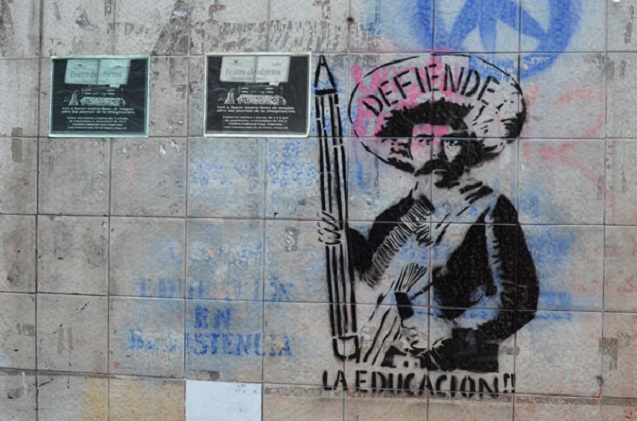 Stencils and graffiti have lined the major avenues of the marches. Here the iconic Emiliano Zapata holds a pencil stating “Defend Education.” (Photo: Andalusia Knoll / Upside Down World).
Stencils and graffiti have lined the major avenues of the marches. Here the iconic Emiliano Zapata holds a pencil stating “Defend Education.” (Photo: Andalusia Knoll / Upside Down World).
Teacher Tanya Olmedo Toledo said this autonomy clause is paving the way for the privatization of education. “Privatization will mean that the poor continue being poor and the rich get richer. Only those who have economic power will be able to access education. And those who can’t will stay behind and be forgotten about – as always,” Olmedo said.
The education reform has mandated that English be taught as a second language. Sagrario Diaz, from the Mazateco region in Oaxaca, has been active in the teachers’ movement and says this mandate ignores the reality of their first nations communities.
“We speak two languages: One is our native language – in my case, it is Mazateco. … If my first language is Mazateco and the second is English, where is the national language included?” Diaz said.
Erandy (who preferred not to give her last name) is a student at a Normal school in Michoacán, part of a national system dedicated to providing rural communities with quality education. Speaking with Truthout, she said she viewed the reform as a “desperate measure to rescue the capitalist system” in which students will be “more complicit with the system and stop questioning it.”
Reform Imposed With an Iron Fist
Peña Nieto has a history of repression. As the governor of Mexico state, which borders Mexico City, he ordered a brutal police operation on the town of San Salvador Atenco, the inhabitants of which had a resisted the construction of an airport on their communal farmland. The operation left two unarmed students dead, numerous activists incarcerated for years and dozens of women sexually assaulted by the police.
During his presidential campaign, tens of thousands marched in the streets against his candidacy, and it is widely believed that he won the elections only because of election fraud.
During Peña Nieto’s inauguration December 1, a collective rage was expressed in the streets by the multitudes protesting his presidency. The police reacted with tear gas, rubber bullets and mass arrests – which resulted in severe injuries to two activists.
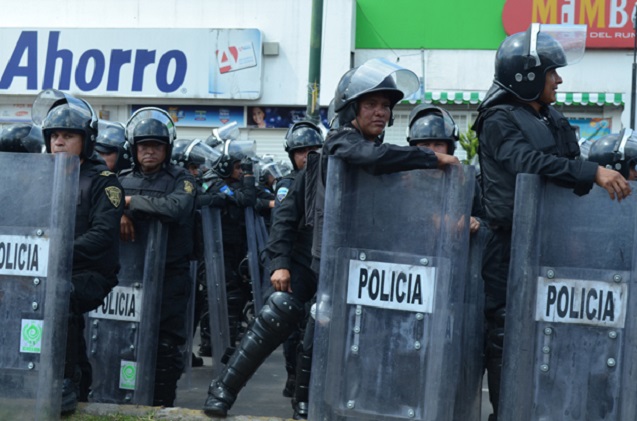 Riot Police have been a constant at many of the mobilizations of the teachers. This photo was taken at a large teachers’ mobilization in protest of the State of the Union address on September 1, minutes before police arrested 16 activists, including 4 independent journalists. (Photo: Andalusia Knoll / Upside Down World).
Riot Police have been a constant at many of the mobilizations of the teachers. This photo was taken at a large teachers’ mobilization in protest of the State of the Union address on September 1, minutes before police arrested 16 activists, including 4 independent journalists. (Photo: Andalusia Knoll / Upside Down World).
Similarly, Peña Nieto has exercised little restraint in confronting the teacher mobilization. Recent events bear witness to this repression. A large protest was planned for Sunday September to coincide with the State of Union address. The president rescheduled his speech, yet the protests continued with tens of thousands of teachers from Oaxaca, Michoacán and Chiapas and allies taking to the streets. Hundreds of riot police were deployed to the protests, and they arbitrarily detained protesters, including three independent media journalists and one blogger who contributed to this article.
Gustavo Ruiz who is a photographer with the news agency Subversiones filmed his own detention, demonstrating that his only crime was questioning why the police were arresting people and filming their actions. Instead of releasing him based on his video, the government charged him with police assault and various other serious crimes on September 1, 2013. They set his bail at 26,000 pesos. And when his friends posted bail, the judge refused to accept it and transferred him and journalist Pavel Primo to the local prison, hiking their bails an additional 100,000 pesos. These two have since been released from the prison, but their charges have not been removed. They have mandatory weekly check-ins at the prison. Another independent journalist, Juan Alberto Arellano Mariano, was arrested two weeks later in Xalapa, Veracruz, during a protest encampment in solidarity with the teachers during the eviction. Ruiz and his fellow journalists and media activists are launching a campaign reaffirming their human right to inform and be informed.
A few days later, teachers protested on one of the major avenues and were met with police repression, which, according to witnesses, left at least 12 people injured.
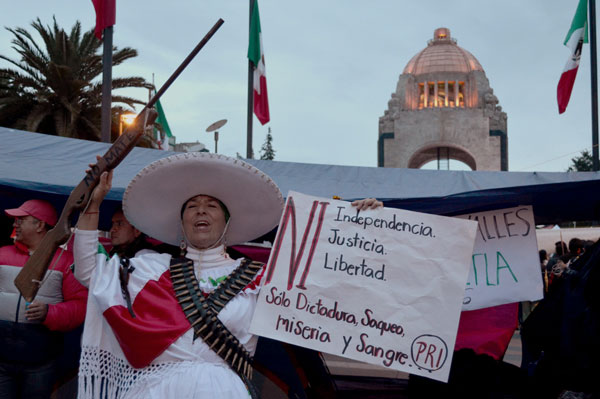 “We don’t have independence, justice or liberty. We only have a dictatorship of exploitation, misery and bloodshed.” (Photo: Andalusia Knoll / Upside Down World).
“We don’t have independence, justice or liberty. We only have a dictatorship of exploitation, misery and bloodshed.” (Photo: Andalusia Knoll / Upside Down World).
As the independence celebration neared the corner, Mexican Secretary of State Miguel Angel Osorio Chong issued an eviction order, stating that the teachers would need to leave the plaza by 4 PM. While some members of the teachers union agreed to obey the orders, the majority who were with section 22 from Oaxaca said they would not comply. Osorio Chong assured Televisa TV that “federal police were at all moments carefully protecting the rights of all people with certain protocols to avoid any kinds of mishaps.”
In an interview with Truthout, Benito Vasquez, press secretary for the Oaxacan Teachers Union, questioned Osorio Chong’s statement. “They say their operation was in accordance with human rights standards, but we were repressed by the federal police and members of the national guard dressed as civilians. They attacked with tanks, tear gas and explosives. There were 31 people detained, our fellow teachers were assaulted, and our general secretary was attacked by the federal police.”
Guillermo Lopez Ruiz, a teachers union representative from Oaxaca, stood guard in the Zócalo and told Truthout that many of his fellow teachers were injured in the eviction. “They say they dialogue with us, but it falls on deaf ears. And when they end their simulation of dialogue, then comes the repression,” Lopez said.
During the eviction, students across Mexico City blocked major avenues in solidarity. Teachers all over the country blocked highways and filled plazas to show their support. The teachers protesting in Mexico City fled the police forces and took refuge a mile away at the Monument of the Revolution, where they set up a new encampment. Hard rains fell all weekend, and thousands of donations poured in, as most teachers had lost all their belongings – tents and tarps included – in the eviction.
On September 15, 2013, nearly 10,000 teachers, students and members of civil society marched in support of the teachers union and held an “alternative grito” celebration marking Mexico’s independence at the new encampment. More teachers have arrived from various states to pressure the government to continue negotiating with the teachers union. Chapters of the CNTE are occupying the plazas in Veracruz and also Oaxaca City, and teachers are mobilizing in 20 additional states. In Mexico City, the union is discussing the possibility of reoccupying the Zocalo, which has remained under police and military control since the independence celebrations. A national strike is planned in the coming days.
Our most important fundraising appeal of the year
December is the most critical time of year for Truthout, because our nonprofit news is funded almost entirely by individual donations from readers like you. So before you navigate away, we ask that you take just a second to support Truthout with a tax-deductible donation.
This year is a little different. We are up against a far-reaching, wide-scale attack on press freedom coming from the Trump administration. 2025 was a year of frightening censorship, news industry corporate consolidation, and worsening financial conditions for progressive nonprofits across the board.
We can only resist Trump’s agenda by cultivating a strong base of support. The right-wing mediasphere is funded comfortably by billionaire owners and venture capitalist philanthropists. At Truthout, we have you.
We’ve set an ambitious target for our year-end campaign — a goal of $250,000 to keep up our fight against authoritarianism in 2026. Please take a meaningful action in this fight: make a one-time or monthly donation to Truthout before December 31. If you have the means, please dig deep.